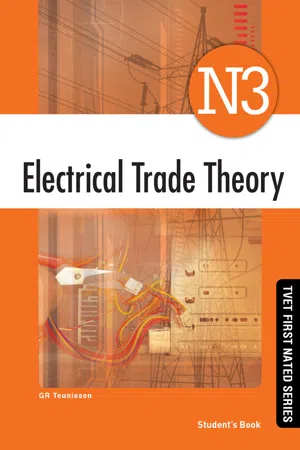
This is a test
- English
- PDF
- Available on iOS & Android
eBook - PDF
Book details
Table of contents
Citations
About This Book
Easy-to-follow content with worked examples to facilitate understanding. Additional language support for new concepts and terminology with a glossary. Information boxes for formulae and important rules.
Frequently asked questions
At the moment all of our mobile-responsive ePub books are available to download via the app. Most of our PDFs are also available to download and we're working on making the final remaining ones downloadable now. Learn more here.
Both plans give you full access to the library and all of Perlego’s features. The only differences are the price and subscription period: With the annual plan you’ll save around 30% compared to 12 months on the monthly plan.
We are an online textbook subscription service, where you can get access to an entire online library for less than the price of a single book per month. With over 1 million books across 1000+ topics, we’ve got you covered! Learn more here.
Look out for the read-aloud symbol on your next book to see if you can listen to it. The read-aloud tool reads text aloud for you, highlighting the text as it is being read. You can pause it, speed it up and slow it down. Learn more here.
Yes, you can access Electrical Trade Theory N3 Student's Book by GR Teunissen in PDF and/or ePUB format, as well as other popular books in Technology & Engineering & Engineering General. We have over one million books available in our catalogue for you to explore.
Information
Table of contents
- Front Cover
- Title Page
- Imprint Page
- Contents
- MODULE 1: Safety precautions
- Unit 1.1: Safety precautions
- Unit 1.2: Earthing
- Unit 1.3: Types of low voltage (LV) earthing systems
- Unit 1.4: Testing installations
- Summary
- Summative assessment
- MODULE 2: Protective devices
- Unit 2.1: Protective devices in motor-control circuits
- Unit 2.2: Miniature circuit breakers (MCB)
- Unit 2.3: Earth-leakage protection
- Summary
- Summative assessment
- MODULE 3: Domestic appliances
- Unit 3.1: Portable appliances
- Unit 3.2: Stationary appliances
- Unit 3.3: Fixed appliances
- Summary
- Summative assessment
- MODULE 4: Illumination
- Unit 4.1: Incandescent lamps
- Unit 4.2: High-pressure mercury vapour discharge lamps
- Unit 4.3: Low-pressure mercury lamps (fluorescent lamps)
- Unit 4.4: Sodium discharge lamps (low pressure)
- Unit 4.5: Neon advertisements
- Unit 4.6: Stroboscopic effects
- Summary
- Summative assessment
- MODULE 5: Motors and allied equipment
- Unit 5.1: Alternating current (AC) motors
- Unit 5.2: Single-phase induction motors
- Unit 5.3: Reversing the direction of single-phase induction motors
- Unit 5.4: Power factor of induction motors
- Unit 5.5: Comparison of single-phase and three-phase induction motors
- Unit 5.6: Universal or series motors
- Unit 5.7: Reversing the direction of rotation of universal motors
- Unit 5.8: Repulsion-start motors
- Unit 5.9: Shaded-pole motors
- Unit 5.10: Direct current (DC) motors
- Unit 5.11: Field connections
- Unit 5.12: Starting DC motors
- Unit 5.13: Reversal of rotation in DC motors
- Unit 5.14: Maintenance of DC motors
- Unit 5.15: Testing motor windings
- Unit 5.16: Protective devices for motors
- Summary
- Summative assessment
- MODULE 6: Alternating current and voltage
- Unit 6.1: Basic alternator
- Unit 6.2: Sine wave
- Unit 6.3: Components in alternating circuits
- Unit 6.4: Resistance and inductance in series
- Unit 6.5: Resistance and capacitance in series
- Unit 6.6: Resistance, inductance and capacitance in series
- Unit 6.7: Resonance
- Summary
- Summative assessment
- MODULE 7: Power and power factor
- Unit 7.1: Apparent power
- Unit 7.2: True (actual) power
- Unit 7.3: Power factor
- Unit 7.4: Disadvantages of poor power factor
- Unit 7.5: Power factor control
- Unit 7.6: The kVA diagram
- Unit 7.7: Active and reactive components of current
- Unit 7.8: Three-phase AC supply systems
- Unit 7.9: Star and delta connections
- Unit 7.10: Three-phase systems
- Unit 7.11: Power in a three-phase circuit
- Unit 7.12: Efficiency
- Summary
- Summative assessment
- MODULE 8: Transformers
- Unit 8.1: Construction and operation of a basic transformer
- Unit 8.2: Transformer ratios
- Unit 8.3: Phasor diagram of a transformer
- Unit 8.4: Single-phase transformer calculations
- Unit 8.5: Power-rating of single-phase transformers
- Unit 8.6: Three-phase transformers
- Unit 8.7: Three-phase transformer calculations
- Unit 8.8: General construction of transformers
- Unit 8.9: Transformer cooling
- Unit 8.10: Protection against internal faults
- Unit 8.11: Auto-transformers
- Unit 8.12: Instrument transformers
- Summary
- Summative assessment
- MODULE 9: Measuring instruments
- Unit 9.1: Basic construction and operation of analogue measuring instruments
- Unit 9.2: Moving-iron instruments
- Unit 9.3: Moving-coil instruments
- Unit 9.4: Comparison between moving-iron and moving-coil instruments
- Unit 9.5: Dynamo instruments
- Unit 9.6: Induction wattmeters
- Unit 9.7: Instrument transformers
- Unit 9.8: Multipliers and shunt resistors
- Summary
- Summative assessment
- MODULE 10: Electronics
- Unit 10.1: Conductors
- Unit 10.2: Insulators
- Unit 10.3: Semi-conductors
- Unit 10.4: Forming of N- and P-type materials
- Unit 10.5: P-N junction diodes
- Unit 10.6: Construction of a diode
- Unit 10.7: Depletion layer
- Unit 10.8: Use of diodes
- Unit 10.9: Transistors
- Unit 10.10: Amplifier circuits
- Unit 10.11: Transistor care
- Unit 10.12: Possible exam questions
- Summary
- Summative assessment
- Glossary
- Back Cover